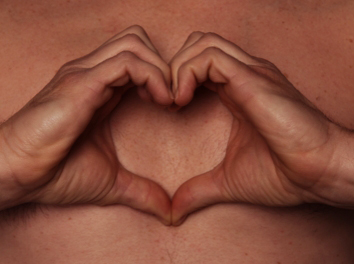Head to toe
 Skin: The average person has about 17 square feet of skin, and in varying degrees most of it is exposed to the sun at some point. While some still pursue the tanned look, there is now no doubt that protecting the skin from the sun decreases wrinkles and the chance of skin cancer. To see what your skin would look like with no lifetime of damaging sun exposure, look behind you—skin on the buttocks (in most people) has no sun damage, and is an instructive before-and-after comparison. The best way to keep skin looking young? Stay out of the sun and don’t smoke. If you do these two things, it will have more positive influence on your skin than all the creams, lotions, potions, and nostrums ever invented.
Skin: The average person has about 17 square feet of skin, and in varying degrees most of it is exposed to the sun at some point. While some still pursue the tanned look, there is now no doubt that protecting the skin from the sun decreases wrinkles and the chance of skin cancer. To see what your skin would look like with no lifetime of damaging sun exposure, look behind you—skin on the buttocks (in most people) has no sun damage, and is an instructive before-and-after comparison. The best way to keep skin looking young? Stay out of the sun and don’t smoke. If you do these two things, it will have more positive influence on your skin than all the creams, lotions, potions, and nostrums ever invented.
Blood: The average person has about five quarts of blood in his or her body. The blood serves as the body’s main transport system, taking oxygen to cells and removing waste products. It also serves as a defense against infection. A blood test at the doctor’s can reveal volumes about your health. One of the most important facts gleaned from a blood test is cholesterol level, because high cholesterol raises the risk for heart attack and stroke.
Brain: The brain has more than 100 billion neurons that connect to thousands of other neurons each, so that the brain has more than 100 trillion connections. A stroke, in which blood supply is interrupted to brain cells, short circuits some of those connections, leading to possible loss of movement, loss of speech or other brain function, or even death.
 Hair: The average person has about 100,000 scalp hairs (brunettes have the most, redheads the fewest) of which 30 to 100 fall out each day. New hair grows in place of the strands that fall out. Hair stands on end when you are cold or scared because of the contraction of a tiny muscle at the base of each follicle.
Hair: The average person has about 100,000 scalp hairs (brunettes have the most, redheads the fewest) of which 30 to 100 fall out each day. New hair grows in place of the strands that fall out. Hair stands on end when you are cold or scared because of the contraction of a tiny muscle at the base of each follicle.
Spine: Thirty-three vertebrae make up the spine, from the base of the skull to the coccyx, and these bones and the cartilage between them allow movement and the signature human trait of standing up straight.
Hips: In women hips are wider in proportion to the body than in men, and with every step we take, about three times our weight is put on our hip bones. Because women live longer and are more likely to have osteoporosis, broken pelvis bones are often a prelude to a permanent loss of mobility. Good nutrition and exercise throughout life can reduce the chances of problems. Bonus fact: One study of world-class runners suggests that the hips and thighs are a woman’s secret weapon in some sports. Because of a woman’s broader hips, her thighbones have a different angle from a man’s, causing her stride to differ in ways that can work to her advantage. Taking height into account, women take longer strides and more strides per minute when running.
 Heart: During the average lifetime, this trusty organ will beat more than 2.5 billion times. It’s able to do this because the cardiac muscle has about 30 percent mitochondria, the part of the cell that converts food to energy. (A skeletal muscle, by contrast, is about 2 percent mitochondria). One of the main things that can damage the heart is high blood pressure, which is easily detected and usually easily treated, by some combination of weight loss, diet, exercise or medication.
Heart: During the average lifetime, this trusty organ will beat more than 2.5 billion times. It’s able to do this because the cardiac muscle has about 30 percent mitochondria, the part of the cell that converts food to energy. (A skeletal muscle, by contrast, is about 2 percent mitochondria). One of the main things that can damage the heart is high blood pressure, which is easily detected and usually easily treated, by some combination of weight loss, diet, exercise or medication.
Breasts: Most breast cancer is found by the woman herself, not by a health care provider. The earlier the detection, the greater the chance of a cure. But of lumps found in the breasts, 80 percent are benign. There is some controversy about it, but many health care providers say women should begin getting regular mammograms at age 40.
Cervix: The story of cervical cancer is one of the great success stories of medicine. Since the Pap test was introduced about 60 years ago, the death rate from cervical cancer has plunged 70 percent.
 Digestive system: The intestines are filled with up to a hundred trillion—read that number again, slowly—microorganisms. Some of them help in digestion, but many haven’t even been identified because they’re difficult to culture. The human body as a whole has up to 10 times more microorganisms than body cells, so most of the cells that make up what the world knows as “you” are really individual life forms that happen to live in and on you.
Digestive system: The intestines are filled with up to a hundred trillion—read that number again, slowly—microorganisms. Some of them help in digestion, but many haven’t even been identified because they’re difficult to culture. The human body as a whole has up to 10 times more microorganisms than body cells, so most of the cells that make up what the world knows as “you” are really individual life forms that happen to live in and on you.
Urinary tract: Women are much more likely than men to develop urinary tract infections. Female anatomy makes it easier for bacteria to get into the urethra, from which they can spread up the ureters to the bladder and kidneys. Best ways to prevent such infections: wipe from front to back, to keep bacteria from the rectum away from the opening of the urethra; take showers instead of tub baths; and drink plenty of fluids. In men, poor urinary flow may be a sign of prostate problems.
 Knees: Women who are active in sports are much more likely to suffer a knee injury than men. Why? One study suggests it’s because many active women have stronger quadriceps (the muscle at the front of the knee) than hamstrings (at the back). Tightening the quadriceps thus puts stress on the knee, potentially leading to injury.
Knees: Women who are active in sports are much more likely to suffer a knee injury than men. Why? One study suggests it’s because many active women have stronger quadriceps (the muscle at the front of the knee) than hamstrings (at the back). Tightening the quadriceps thus puts stress on the knee, potentially leading to injury.
Feet: The skin on the soles of the feet is the thickest skin on the body, and contains more sweat glands and pressure-sensitive nerve endings per square inch that any other part of the body. The most common cause of foot pain and problems in women: poorly-fitting shoes.
Leave a Response